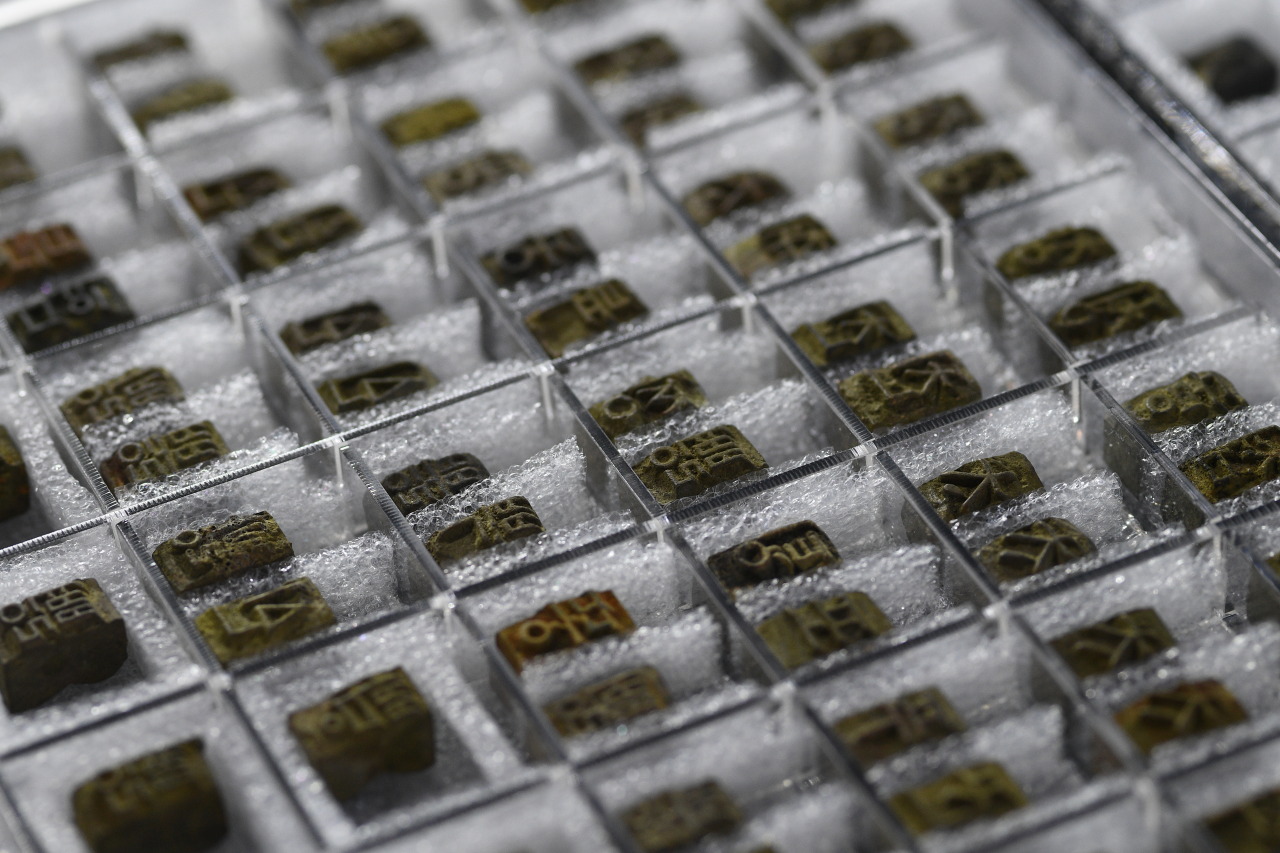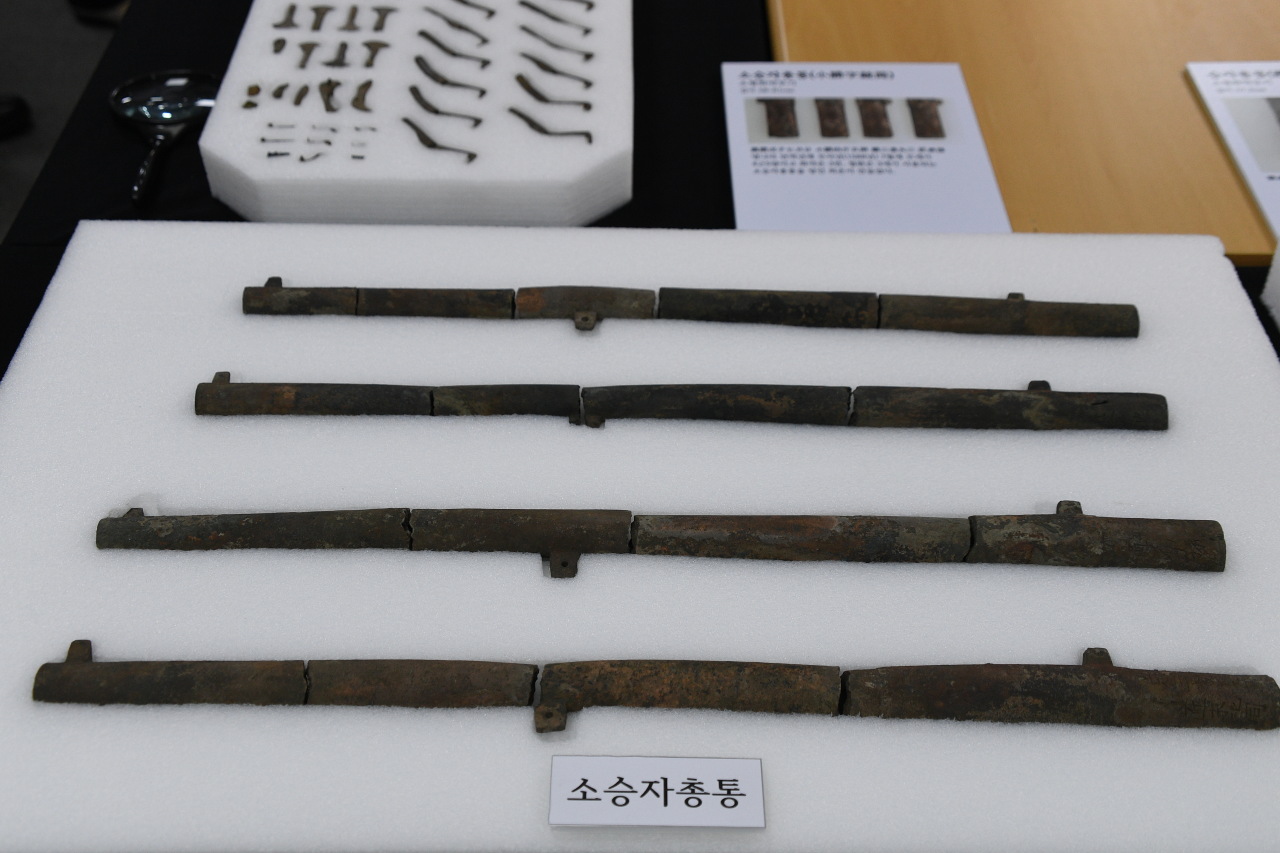Metal type blocks from King Sejong’s reign discovered
By Song Seung-hyunPublished : June 29, 2021 - 17:16

The Sudo Research Institute of Cultural Heritage has excavated more than 1,600 pieces of metal type blocks from the early Joseon era in Insa-dong in Jongno, central Seoul, according to the Cultural Heritage Administration on Tuesday.
“We found around 1,600 pieces of Hangeul and Chinese character metal type blocks,” head of the Sudo Research Institute of Cultural Heritage Oh Kyung-taek said during a press conference Tuesday. “We estimate that the relics are from the 15th to 16th centuries.”
Oh added that the findings are expected to help experts better understand how advanced science was during the ruling of King Sejong (1397-1450) of the Joseon era.
The metal type blocks were found in a pot that was buried in the ground, along with other metal artifacts. Currently, all the excavated artifacts have been transferred to the National Palace Museum of Korea for preservation and further research.
The type blocks are especially meaningful because they reflect the writing style of the time when Hunminjeongeum, a document explaining the new script for the Korean language written by King Sejong (1397―1450), was created. It is also the first case that the Dongguk Jeongun-style orthography, which was only used in the 15th century, has been found on type blocks.
“Since it uses Dongguk Jeonghan-style orthography, we can assume that it is the oldest metal type blocks that exist,” said professor Baek Doo-hyun of Kyungpook National University’s department of Korean language and literature.
So far the oldest existing metal type blocks found were from 1455, which was created during the ruling of King Sejo.
About 10 pieces of Yeonju metal type blocks, which were used to imprint conjunctions that connect two sporadic letters, were also discovered as well.
Along with the type blocks, copper artifacts that appear to be fragments of Jujeon, which is an engraved visual scale part that tells time on a water clock, were also in the pot. The copper pieces are estimated to be from 1438 or 1536.

The Ilseongjeongsiui, an astronomical clock that can be used in both day and night, was discovered next to the pot, with eight chongtong, which are small firearms. The chongtong, which are around 50-60 centimeters in length, were intentionally broken into pieces and buried, according to the CHA.
Moreover, a bronze bell was excavated underneath the Ilseongjeongsiui. The bell was also broken into several small fragments.
“It seems like the items were broken into pieces and buried intentionally. We do not know why it was buried at the time yet,” Oh said.
The cultural heritage expert added that he assumes someone could have buried the pot with the intention to retrieve it later, but was unable due to a war or some kind of unexpected event, adding there were other similar cases found in Seoul.
“Near Cheonggyecheon in Seoul, some relics from the 16th and 17th centuries were found, which were buried there intentionally. The owners could not come back to get them due to wars like the Qing invasion of Joseon or Japanese invasion of Joseon,” Oh added.







![[Graphic News] More Koreans say they plan long-distance trips this year](http://res.heraldm.com/phpwas/restmb_idxmake.php?idx=644&simg=/content/image/2024/04/17/20240417050828_0.gif&u=)
![[KH Explains] Hyundai's full hybrid edge to pay off amid slow transition to pure EVs](http://res.heraldm.com/phpwas/restmb_idxmake.php?idx=644&simg=/content/image/2024/04/18/20240418050645_0.jpg&u=20240419100350)






![[From the Scene] Monks, Buddhists hail return of remains of Buddhas](http://res.heraldm.com/phpwas/restmb_idxmake.php?idx=652&simg=/content/image/2024/04/19/20240419050617_0.jpg&u=20240419175937)

![[KH Explains] Hyundai's full hybrid edge to pay off amid slow transition to pure EVs](http://res.heraldm.com/phpwas/restmb_idxmake.php?idx=652&simg=/content/image/2024/04/18/20240418050645_0.jpg&u=20240419100350)

![[Today’s K-pop] Illit drops debut single remix](http://res.heraldm.com/phpwas/restmb_idxmake.php?idx=642&simg=/content/image/2024/04/19/20240419050612_0.jpg&u=)